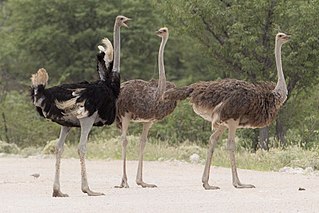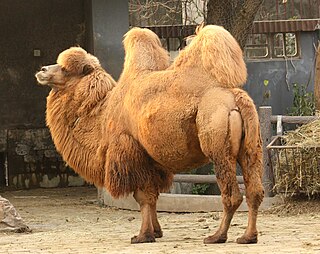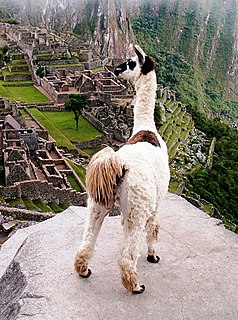Related Research Articles

A camel is an even-toed ungulate in the genus Camelus that bears distinctive fatty deposits known as "humps" on its back. Camels have long been domesticated and, as livestock, they provide food and textiles. Camels are working animals especially suited to their desert habitat and are a vital means of transport for passengers and cargo. There are three surviving species of camel. The one-humped dromedary makes up 94% of the world's camel population, and the two-humped Bactrian camel makes up 6%. The Wild Bactrian camel is a separate species and is now critically endangered.

The common ostrich, or simply ostrich, is a species of flightless bird native to certain large areas of Africa and is the largest living bird. It is one of two extant species of ostriches, the only living members of the genus Struthio in the ratite order of birds. The other is the Somali ostrich, which was recognized as a distinct species by BirdLife International in 2014 having been previously considered a very distinctive subspecies of ostrich.

Camelids are members of the biological family Camelidae, the only currently living family in the suborder Tylopoda. The extant members of this group are: dromedary camels, Bactrian camels, wild Bactrian camels, llamas, alpacas, vicuñas, and guanacos. Camelids are even-toed ungulates classified in the order Cetartiodactyla, along with species like whales, pigs, deer, cattle, and antelopes.

The dromedary is a large even-toed ungulate, of the genus Camelus, with one hump on its back.

The Bactrian camel, also known as the Mongolian camel or domestic Bactrian camel, is a large even-toed ungulate native to the steppes of Central Asia. It has two humps on its back, in contrast to the single-humped dromedary camel. Its population of two million exists mainly in the domesticated form. Their name comes from the ancient historical region of Bactria.

Lama is a genus containing four South American camelids, the wild guanaco and vicuña, and the domesticated llama and alpaca. Before the Spanish conquest of the Americas, llamas and alpacas were the only domesticated ungulates of the continent. They were kept not only for their value as beasts of burden, but also for their flesh, hides, and wool.

Struthio is a genus of birds in the order Struthioniformes, whose members are the ostriches. It is part of the infra-class Palaeognathae, a diverse group of flightless birds also known as ratites that includes the emus, rheas, and kiwis. There are two living species of ostrich: the common ostrich and the Somali ostrich. They are large flightless birds of Africa who lay the largest eggs of any living land animal. With the ability to run at 70 km/h (43.5 mph), they are the fastest birds on land. They are farmed worldwide, particularly for their feathers as they are used as decoration and feather dusters. Their skin is also used for leather products. Ostriches are notable for being the heaviest living birds.

The Somali ostrich, also known as the blue-necked ostrich, is a large flightless bird native to the Horn of Africa. It was previously considered a subspecies of the common ostrich, but was identified as a distinct species in 2014.

Camelini is a tribe of terrestrial herbivores in the family Camelidae, endemic to Asia, North America, and Africa from the Late Eocene to the present. It includes the living genus Camelus as the type genus. At least one genus, Eulamaops, reached South America.

A hybrid camel is a hybrid between a Bactrian camel and dromedary.

The wild Bactrian camel is a critically endangered species of camel living in parts of northwestern China and southwestern Mongolia. It is closely related to the Bactrian camel. Both are large, double-humped even-toed ungulates native to the steppes of central Asia. Until recently, wild Bactrian camels were thought to have descended from domesticated Bactrian camels that became feral after being released into the wild. However, genetic studies have established it as a separate species which diverged from the Bactrian camel about 1.1 million years ago.

Onciderini is a tribe of longhorn beetles of the subfamily Lamiinae, they are prevalent across Europe in nations such as Turkey, and Finland.

Trachysomus is a genus of longhorn beetles of the subfamily Lamiinae, containing the following species:

The North African ostrich, red-necked ostrich, or Barbary ostrich is the nominate subspecies of the common ostrich from West and North Africa. It is the largest subspecies, making it the largest living bird.
Trachysomus arriagadai is a species of beetle in the family Cerambycidae. It was described by Galileo and Martins in 1991. It is known from Argentina, Brazil and Paraguay.
Trachysomus cavigibba is a species of beetle in the family Cerambycidae. It is known to inhabit Bolivia.
Trachysomus gibbosus is a species of beetle in the family Cerambycidae. It was described by Buquet in 1852. It is known from Brazil.
Trachysomus hydaspes is a species of beetle in the family Cerambycidae. It was described by Dillon and Dillon in 1946. It is known from Guyana and French Guiana.
Trachysomus surdus is a species of beetle in the family Cerambycidae. It was described by Dillon and Dillon in 1946. It is known from Panama and Nicaragua.
Camelus thomasi is an extinct species of camel from the Early-Mid Pleistocene of North Africa. It is known primarily from Tighennif (Ternifine) in Algeria, as well as Sudan. Fossils from Israel dated to the Late Pleistocene have been included under C. thomasi, but they are now considered to belong to a different species, making C. thomasi a strictly African species.
References
- ↑ BioLib.cz - Trachysomus camelus. Retrieved on 8 September 2014.